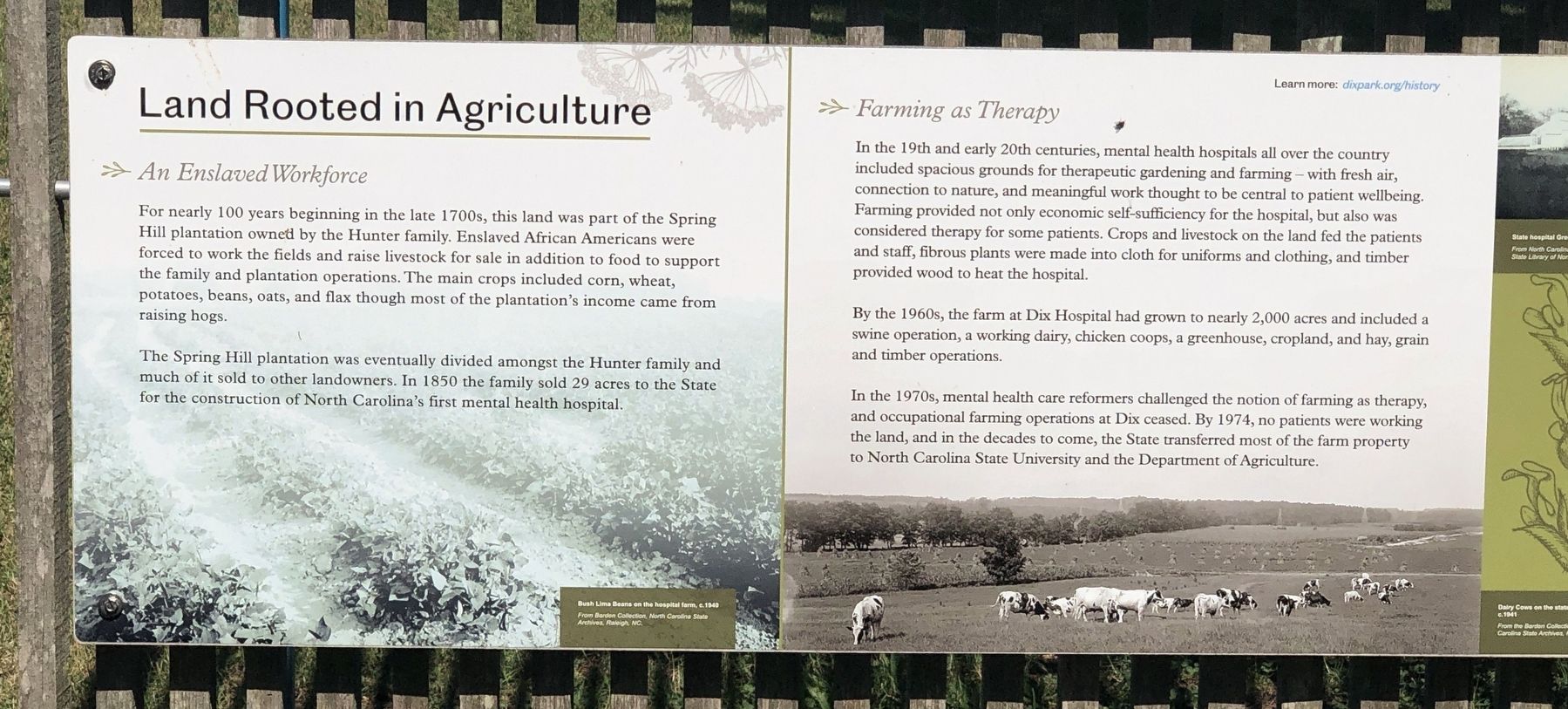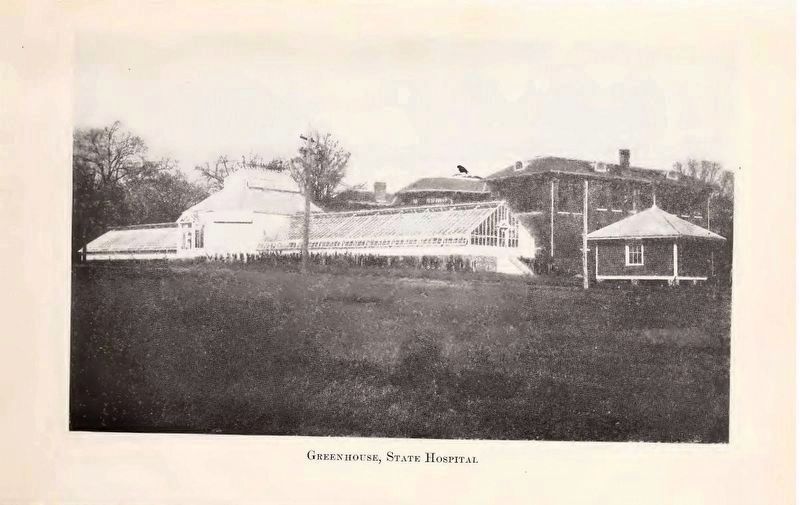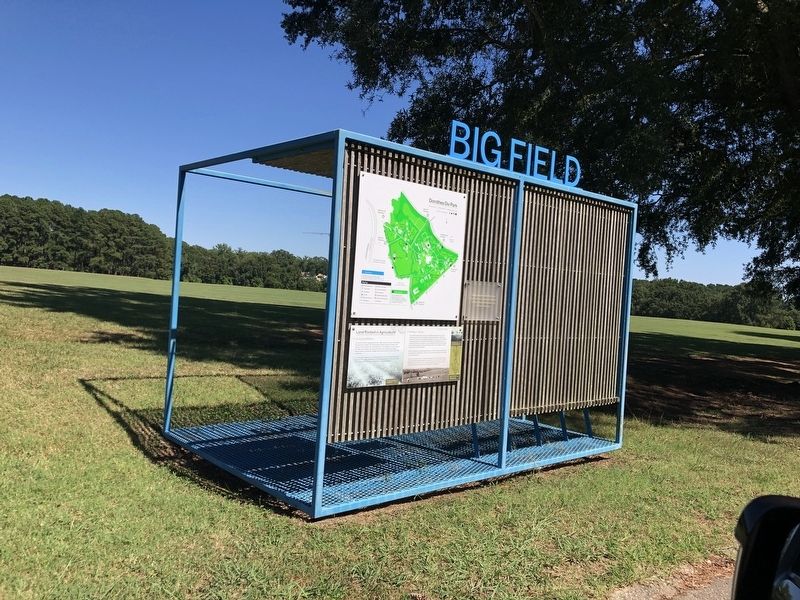Southwest Raleigh in Wake County, North Carolina — The American South (South Atlantic)
Land Rooted in Agriculture
The Spring Hill plantation was eventually divided amongst the Hunter family and much of it sold to other landowners. In 1850 the family sold 29 acres to the State for the construction of North Carolina’s first mental health hospital.
Farming as Therapy In the 19th and early 20th centuries, mental health hospitals all over the country included spacious grounds for therapeutic gardening and farming – with fresh air, connection to nature, and meaningful work thought to be central to patient wellbeing. Farming provided not only economic self-sufficiency for the hospital, but also was considered therapy for some patients. Crops and livestock on the land fed the patients and staff, fibrous plants were made into cloth for uniforms and clothing, and timber provided wood to heat the hospital.
By the 1960s, the farm at Dix Hospital had grown to nearly 2,000 acres and included a swine operation, a working dairy, chicken coops, a greenhouse, cropland, and hay, grain and timber operations.
In the 1970s, mental health care reformers challenged the notion of farming as therapy, and occupational farming operations at Dix ceased. By 1974, no patients were working the land, and in the decades to come, the State transferred most of the farm property to North Carolina State University and the Department of Agriculture.
[Captions (left to right)]
• Bush Lima Beans on the hospital farm, c. 1940. From Barden Collection, North Carolina State Archives, Raleigh, NC
• Dairy Cows on the state hospital farm, c.1941. From the Barden Collection, North Carolina State Archives, Raleigh, NC
• State hospital Greenhouse, c.1916 From North Carolina State Documents Collection, State Library of North Carolina, Raleigh, NC
Topics. This historical marker is listed in these topic lists: African Americans • Agriculture • Science & Medicine. A significant historical year for this entry is 1850.
Location. 35° 46.098′ N, 78° 39.848′ W. Marker is in Raleigh, North Carolina, in Wake County. It is in Southwest Raleigh. Marker is on Barbour Drive, 0.1 miles south of Blair Drive, on the left when traveling south. Marker is
on the shelter at The Big Field at Dix Park. Touch for map. Marker is at or near this postal address: 812 Barbour Dr, Raleigh NC 27603, United States of America. Touch for directions.
Other nearby markers. At least 8 other markers are within walking distance of this marker. The First People (approx. 0.3 miles away); Dix Hospital Cemetery (approx. 0.3 miles away); Spring Hill (approx. 0.3 miles away); Life on Dix Hill (approx. 0.4 miles away); Central Prison (approx. 0.6 miles away); Dorothea Dix Hospital (approx. 0.6 miles away); The Civil War Arrives in Raleigh (approx. 0.7 miles away); The Governor Morehead School (approx. 0.7 miles away). Touch for a list and map of all markers in Raleigh.
Also see . . . Slave Narratives: A Folk History of Slavery in the United States from Interviews with Former Slaves. Transcripts of interviews with former slaves in North Carolina that were conducted in the 1930s as part of a New Deal program. Among those interviewed was Elbert Hunter, who was born into slavery on Spring Hill plantation in 1844. (The Federal Writers Project, via National Archives) (Submitted on September 24, 2023, by Duane and Tracy Marsteller of Murfreesboro, Tennessee.)

via Jacob Hunter Trust (Public Domain)
4. Col. Theophilus Hunter, Sr.
The Revolutionary War veteran owned Spring Hill plantation, a portion of which later became Dorothea Dix State Hospital. The 45 slaves he owned in 1790 made him the second-largest enslaver in Wake County. When he died in 1798, his will bequeathed 56 enslaved people to his heirs. Hunter's son, Theophilus Jr., expanded Spring Hill's slaveholdings to 65 in 1830.
Credits. This page was last revised on September 24, 2023. It was originally submitted on September 24, 2023, by Duane and Tracy Marsteller of Murfreesboro, Tennessee. This page has been viewed 59 times since then and 17 times this year. Photos: 1, 2, 3, 4. submitted on September 24, 2023, by Duane and Tracy Marsteller of Murfreesboro, Tennessee.


